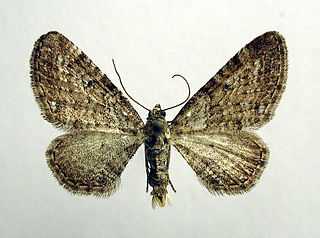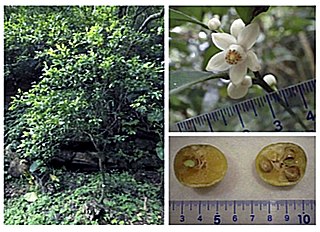
Eupithecia is the largest genus of moths of the family Geometridae, and the namesake and type genus of tribe Eupitheciini. Species in the genus are, like those of other genera in the tribe, commonly known as pugs. The genus is highly speciose, with over 1400 species, and members of the genus are present in most of the world with exception of Australasia. Roughly a quarter of described Eupithecia species occur in the Neotropical realm, where they have an especially high species diversity in the montane rain forests of the Andes. The genus includes a few agricultural pest species, such as the currant pug moth, Eupithecia assimilata, which is a pest on hops, and the cloaked pug moth, Eupithecia abietaria, which is a cone pest in spruce seed orchards.

The juniper pug or juniper looper is a moth of the family Geometridae. The species was first described by Michael Denis and Ignaz Schiffermüller in 1775. It is found throughout the Palearctic and in the Nearctic.

Eupithecia satyrata, the satyr pug, is a species of moth of the family Geometridae. It was described by Jacob Hübner in 1813. It is found from Ireland, through northern and central Europe east to all of Russia and central Asia and western Siberia to Tibet. It is also present in North Africa and North America.

Eupithecia pernotata, or Guenée's pug, is a moth of the family Geometridae. The species was first described by Achille Guenée in 1857. It is known from the Alps, through Romania to southern Russia. It is also found in Finland.

Eupithecia niveifascia is a moth in the family Geometridae first described by George Duryea Hulst in 1898. It is found in North America from south-western Alberta west to Vancouver Island, north to northern coastal British Columbia and south to New Mexico.
Eupithecia albidulata is a moth in the family Geometridae. It is found in the Caucasus.

Eupithecia subbrunneata is a moth in the family Geometridae. It is found in China and Russia.
Eupithecia duena is a moth in the family Geometridae. It is found in Ecuador and Peru.
Eupithecia infimbriata is a moth in the family Geometridae. It is found in Peru.
Eupithecia interrubrescens is a moth in the family Geometridae. It is found in Tibet.
Eupithecia irambata is a moth in the family Geometridae. It is found in India (Sikkim).
Eupithecia junctifascia is a moth in the family Geometridae. It is found in Colombia and Costa Rica.
Eupithecia lacteolata is a moth in the family Geometridae. It is found in Russia and Turkey.
Eupithecia leucographata is a moth in the family Geometridae. It is found in Mexico.
Eupithecia mediobrunnea is a moth in the family Geometridae. It is found in Mexico.
Eupithecia mejala is a moth in the family Geometridae. It is found in Ecuador, Bolivia and Peru.
Eupithecia muscula is a moth in the family Geometridae. It is found in Mexico.
Eupithecia subsequaria is a moth in the family Geometridae. It is found in Turkey.
Eupithecia virescens is a moth in the family Geometridae. It is found in Brazil.

Citrus ryukyuensis, also known as the tanibuta, is a newly characterized wild citrus species native to the Ryukyus and adjacent islands, most closely related to the mainland mandarin orange, C. reticulata. As with other citrus, it is a member of the Rutaceae family. The Ryukyu and mainland species have diverged for more than 2 million years, and unlike the mainland mandarin, the Ryukyu mandarin reproduces sexually. Its hybridization with the mainland species has given rise to the unique mandarin hybrids of the islands.






